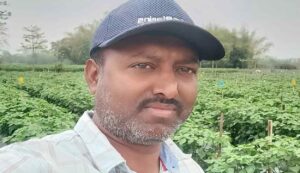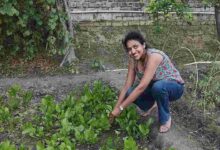Success Story: Know how this farmer from Assam turned 50 bighas of land into a profitable business
Success Story: A 43-year-old farmer from Assam’s Golaghat district, Asgar Ali has been a lifelong farmer for more than 25 years. Ali, who only completed the eighth grade, has shown that creativity, flexibility, and market knowledge are more important for success in agriculture than degrees. Using a clever fusion of ancient knowledge and contemporary marketing, he grows a wide range of fruits and vegetables, earning millions of rupees a year, making him a model farmer in his area today.

A Variety of Fruits and Vegetables Grown on 50 Bighas
Ali cultivates a variety of crops on his 50-bigha plot, such as watermelons, sweet potatoes, brinjal, tomatoes, papayas, king chillies, and regional chilli types. Among them, his creative technique of growing papaya alongside king chilli and watermelon alongside papaya in a zigzag pattern over four bighas has garnered notice due to its remarkable financial returns as well as its astute use of space.
Sustainable Practices: Equilibrium Chemical and Organic Inputs
Ali considers the long-term well-being of his crops and land. He uses a balanced approach to fertilisation and plant protection since he is aware of the negative consequences of using too many chemical pesticides and fungicides. Ali only applies chemical sprays when absolutely required, despite the fact that vegetable crops are susceptible to insect infestations, particularly during the blossoming period.
He often uses cow manure and vermicompost, which are natural fertilisers that help preserve soil fertility without leaving any negative residues, to enhance the soil. In addition to ensuring healthy crops, this balance between chemical and organic inputs promotes sustainability.
Expanding Farmer Assistance and Seed Access
Ali’s agricultural adventure has been profoundly changed by the increased availability of high-quality seeds. Farmers in isolated areas like Golaghat had trouble finding trustworthy seed types a few years ago. But the network for distributing seeds has now grown considerably. Representatives of the firm now come to his property with only one phone call and bring seeds right to his door. Since this change has saved time and money, more farmers in rural Assam are being inspired to improve their agricultural practices.
According to Ali, this trend will help close the gap between farmers and agribusiness service providers and is a significant step toward agricultural self-reliance.
Space-Smart and Weather-Resilient Agriculture
Ali’s most noteworthy invention is the zigzag pattern he used to intercrop watermelon and papaya and king chilli with papaya. The goal of this design is to maximise profits while making the greatest use of the restricted amount of land. His approach is to first prepare the field with fresh cow dung—more precisely, two trolley loads of cow dung distributed throughout the ground—because papaya needs a greater source of nutrients.
He uses a 3:1 planting ratio once the cow manure has dried and been incorporated into the soil. In two bigha plots, he plants three king chilli plants after each papaya plant, and in another two bigha plot, he plants watermelon and papaya in the same arrangement. In addition to making the most use of available space, this design helps both crops absorb nutrients from the soil and get sunshine.
Additionally, the zigzag intercropping method provides protection from Assam’s erratic weather. Heavy rains and unexpected storms are common in the area, which may harm delicate crops like watermelons and king chillies. Nonetheless, the more resilient papaya plants provide some physical defence, protecting the watermelon and king chilli plants and lessening the overall effects of bad weather. Papaya branches may be recycled for future cultivation even if they break during such occurrences, guaranteeing revenue continuation. However, Ali said that since papaya trees are very vulnerable to waterlogging, this kind of technique is only feasible in highland regions.
With the same amount of inputs and far greater results than traditional monocropping, this creative technique has allowed Ali to make almost twice as much money.
Going Digital
Asgar Ali has chosen a different path, although many farmers find it difficult to locate the ideal market or get reasonable rates for their goods. In order to establish a direct channel of contact with both traders and customers, he has embraced social media and digital technologies. He begins marketing his crops via agricultural forums, WhatsApp communities, and Facebook groups as soon as the seeds are sown.
In order to generate interest in his methods and food, he regularly invites YouTubers and other agricultural influencers to visit his farm. He also utilises websites like Krishi Jagran to expand his audience and make sure that consumers searching for high-quality agricultural food see his crops.
Because of this proactive marketing strategy, there will already be a market for his crop when it is ready to be harvested. Because of his increased internet awareness, he never has any trouble selling his crops and often gets premium prices.
An Example for Today’s Farmers
What can be accomplished with creative thinking, flexibility, and an openness to learning is shown by Asgar Ali’s narrative. His story is really motivating, as he went from being a farmer with little money and no formal education to being a commercial grower with a significant online following.
In addition to increasing his income, he has set an example for thousands of farmers in Assam and abroad by combining sustainable farming methods with astute marketing and creative intercropping. According to Asgar, social media is the greatest way for farmers to advertise their goods, get in touch with consumers, and keep up with the most recent developments in agriculture.





